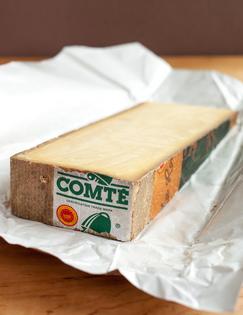The Kitchn: Why Comte cheese needs to be in your fridge
Cheese, generally speaking, is not a tough sell. Even so, it can be hard to convince someone -- even a cheese-loving someone, like myself -- to stray from the usual cheesy standbys and try something new. Sure, we'll pick up a little round of artisan goat cheese or a wedge of imported Brie for a party, but when it comes to weeknight frittatas and grilled cheese, we all have our favorites.
Here's one that is perhaps new to you: Comte cheese. This creamy, nutty-tasting French cheese absolutely deserves a spot in your fridge. Here's why!
--Comte is versatile.
Comte is a great snacking cheese, whether we're talking an afternoon snack with crackers or as part of a fancy dinner party cheese plate. It has this nutty, earthy flavor and a creamy texture that I really love -- it's one of those cheeses that always has me coming back for more.
But I've also found that Comte is a great cheese for cooking. Those same nutty flavors work well in a bowl of macaroni and cheese, sprinkled over vegetables, or folded into a plate of eggs. It's a fairly firm cheese, so it can be sliced, cubed or grated as needed.
I'll also give Comte bonus points for being long-lasting -- a characteristic that always gets bonus points in my kitchen. If you buy a wedge for a party and then forget about the leftover hunk in your fridge for a week or three, it will be fine -- which, in fact, is how Comte maneuvered its way out of the "special occasion" category and into my regular cheese rotation to begin with.
--Comte comes with a story.
Comte cheese has a PDO designation -- Protected Designation of Origin -- from the European Union. This means that for Comte cheese to truly be Comte cheese, it can only be made within a certain area and following a certain fairly strict procedure. The name of that area is the Jura -- it's in the eastern part of France, and it just so happens to have a particular alpine and sub-alpine climate that is perfect for raising dairy cows and making cheese.
How Comte cheese is actually made is where the story gets interesting. There are three separate groups involved in the process: the dairy farmers, the people who make the cheese, and the people who age the cheese. Each group takes care of their stage in the process independently, but they also all collaborate closely. It's a system of checks and balances that has evolved over centuries of cheese-making, all for the benefit of the cheese.
Comte is a raw milk cheese made from the milk of pasture-fed cows, and the milk for each round of cheese can only come from within a few miles of the cheese maker. This means that each round of cheese has a very distinct terroir -- that certain stamp of flavors and aromas that can only come from a very particular place. Furthermore, the milk is delivered to the cheese maker daily and has to be used immediately, so cheeses also get a seasonal stamp. Summer Comte and winter Comte, Comte from the mountains and Comte from the plains -- each will be different and no two wedges will be quite the same.
The big 80-pound wheels of Comte also have to be aged for a minimum of four months, but are often aged for longer. As they age, the flavors intensify and the texture of the cheese becomes more firm. You might notice small crunchy crystals in a very aged Comte -- a sign of maturity and distinction!
Buying Comte cheese:
Comte isn't quite as common or widely available as cheeses like Parmesan or Gruyère, but it's getting there! You can now find it at Whole Foods, Wegman's, Costco, many Trader Joe's, and most well-stocked cheese counters. If you don't see it, ask for it!
Since each wedge of Comte is a little different, be sure to try the Comte before you buy it, especially if you're choosing between different wheels. Summer Comte will have a golden hue with a richer, earthier flavor. Winter Comte is more milky-colored and delicate. Young and aged cheeses are both great for cheese plates and for cooking, but you might find that you prefer one over the other. It's a little trickier to find out where the cheese was made, plains or mountains, but ask the cheesemonger -- if they know, they can explain the flavor differences.
(Emma Christensen is recipe editor at TheKitchn.com, a nationally known blog for people who love food and home cooking. Submit any comments or questions to kitchn@apartmenttherapy.com.)







